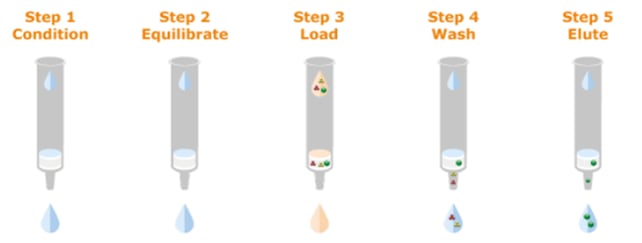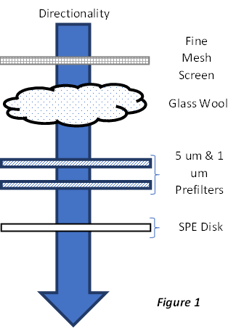When you are extracting SVOCs from aqueous samples and analyzing via Gas Chromatography (GC), every step within a solid phase extraction (SPE) procedure is imperative, but one of the most important steps that must be done properly is the air-dry step post sample loading.
If you have ever used SPE in your laboratory, you may be familiar with the steps displayed in the image below. For those of you who have a lot of experience with SPE may be aware that there is sometimes an air-dry step immediately following the sample loading step or the wash step (if there is a wash step).

Here are some of the reasons why you should be using an air-dry step in your SPE workflow:
Improve Recoveries of Polar and Non-Polar Compounds
Post sample load, it is important to have a long enough air-dry step because the more residual water that is removed from the sorbent, the more polar analytes will stick to the media bed instead of remaining with the water. The water can also create a barrier in the media bed preventing your non-polar solvents from being able to extract the analytes of interest or eluting the solvent at all. Not only that, too much residual water in your extract from an improper air-dry step can pose problems later on in your procedure with the extract drying step.
Now for how long we should be air-drying our SPE for . . . we want to maximize the benefits of air-drying, but we also want to make sure that we don’t sacrifice recovery. There is a “sweet spot” when air-drying your SPE and it is also method dependent. For instance, EPA Method 525.2 says to air-dry the cartridge or disk for 10 minutes. This length of time is the sweet spot for this method because the more residual water that is pulled away, the more effectively the methylene chloride can extract the analytes from the media bed. With this method having mostly polar analytes, this is very beneficial. Feel free to check out what other EPA Methods recommend for the air-dry timing, but remember if the EPA allows it, then you have the flexibility to develop your own “sweet spot” for air-drying your SPE!
Minimize Analyte Loss During the Extract Drying Step
As mentioned earlier, if there is more residual water present within the extracts due to improper air-drying procedures, then more sodium sulfate would be required for drying. If too much sodium sulfate is used, you can risk losing some compounds in the sodium sulfate or needing to use more solvent to rinse the sodium sulfate effectively. It is essential that proper rinsing techniques are exercised to minimize analyte loss in sodium sulfate. If you are using the DryDisk-R®, then there is no need to worry about the extract drying step limiting analyte recovery. During this step it is imperative that you remove all the water from your extracts prior to concentration because when it comes to analyzing your extracts on the GC, it can turn into a disaster.
Improve Analytical Conditions
When you are using a GC for your extract analysis, then you know that it does not like water. It is imperative that proper air-drying procedures are practiced most especially in preparation for this step in your workflow. Residual water in your extract could occur if you had improper air-drying procedures from the start or if you don’t use enough sodium sulfate leading to water breakthrough into what you believe is a “dried” extract. Then, when you analyze your final concentrated extract with the residual water, it can make a huge mess of your analysis data and maintenance would most likely be required to remove the contamination. We know how much of a pain this can be, so be sure to follow good practices when it comes to air-drying your SPE sorbent! Extract Drying (not to be confused with air-drying!):
How Does the Sample Matrix Impact the Air-Dry Step?
Not all SPE methods are for clean drinking water extractions. There are also wastewater and groundwater extractions, and these are not usually very clean. Depending on the sample matrix, you could be using cartridges, disks, or disks with loads of pre-filters. Whichever format you are using for your extraction, it is important to know the nature of the samples being extracted. Your samples could be very clean, and you could use a cartridge or a disk and never have an issue. Or, you could have samples that contain a lot of different particulates and solid matter that can layer up forming a barrier over your SPE sorbent.
There are also wastewater and groundwater extractions, and these are not usually very clean. Depending on the sample matrix, you could be using cartridges, disks, or disks with loads of pre-filters. Whichever format you are using for your extraction, it is important to know the nature of the samples being extracted. Your samples could be very clean, and you could use a cartridge or a disk and never have an issue. Or, you could have samples that contain a lot of different particulates and solid matter that can layer up forming a barrier over your SPE sorbent.
The more dirt and sludge that is caked onto your disk or cartridge, the less effective the air-dry step will be. It is important to plan for those heavily particulate laden samples by adding pre-filters into your disk holder (see figure 1) to ensure that your disk is protected from particulates and sludge which limit the effectiveness of an air-dry step. A great example of this is shown in a case study where real wastewater influent samples and synthetic wastewater (ASTM D905(3)) were extracted following EPA method 608.3.
Read More

 Organic Workflow
Organic Workflow Peptide Workflow
Peptide Workflow Scale-Up Flash Purification
Scale-Up Flash Purification  Sample Preparation
Sample Preparation Biomolecule Purification
Biomolecule Purification Oligo synthesis
Oligo synthesis Scavengers and Reagents
Scavengers and Reagents Service & Support
Service & Support Accessories & Spare parts
Accessories & Spare parts Investors
Investors Reports & News
Reports & News The Share
The Share Corporate Governance
Corporate Governance Calendar
Calendar Sustainability
Sustainability Our Offering
Our Offering Our History
Our History Our Locations
Our Locations Leadership
Leadership